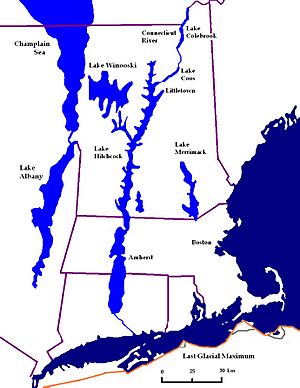Lake Hitchcock facts for kids
Lake Hitchcock was a huge glacial lake that formed about 15,000 years ago. This happened during the late Pleistocene epoch, which is often called the Ice Age. When the giant Laurentide Ice Sheet started to melt and pull back, its water got trapped. A natural dam, called a moraine, blocked the Connecticut River. This created a very long, narrow lake. Lake Hitchcock existed for about 3,000 years. Over time, erosion (wearing away of land) and other natural changes likely caused the lake to drain away. At its longest, Lake Hitchcock stretched from a dam near Rocky Hill, Connecticut, all the way to St. Johnsbury, Vermont. That's about 320 kilometers (200 miles) long! The river valley actually goes further south to New Haven. But the moraine at Rocky Hill made the river turn southeast. This is why the Connecticut River now flows to Old Saybrook and into Long Island Sound.
Contents
How Lake Hitchcock Formed
Lake Hitchcock is a very important part of the geology of Connecticut. It formed when the massive Laurentide Ice Sheet began to melt. This ice sheet covered much of North America. As it melted, huge amounts of water flowed south. This water got blocked by a pile of rocks and dirt. This pile was left behind by the glacier and is called a moraine. The moraine acted like a natural dam. It stopped the water from flowing down the Connecticut River valley. This caused the valley to fill up with meltwater, creating the long lake.
What is a Glacial Lake?
A glacial lake is a lake that gets its water from melting glaciers or ice sheets. These lakes often form in valleys that were carved out by glaciers. They can be very large, like Lake Hitchcock was. They are a common feature during and after an Ice Age.
How Long Did Lake Hitchcock Last?
Lake Hitchcock existed for about 3,000 years. This might seem like a long time to us. But in terms of Earth's history, it's a relatively short period. The lake slowly drained as the natural dam wore away. This happened because of ongoing erosion and other geological changes.
Studying Lake Hitchcock's Past
Scientists have learned a lot about Lake Hitchcock by studying its sediments. Sediments are layers of mud, sand, and clay that settle at the bottom of a lake. Lake Hitchcock had special annual layers called varves.
What are Varves?
Varves are like tree rings for lakes. Each year, two distinct layers of sediment would form.
- During the summer, when the glacier melted a lot, silt and sand would settle. These layers are usually lighter.
- In the winter, when the lake froze over, fine clay particles would settle. These layers are usually darker.
By counting and studying these varve layers, scientists can learn about the lake's history. They can even tell how old the lake was and how fast the glacier was melting.
Research on Lake Hitchcock's Sediments
Scientists John Ridge and Frederick Larsen studied varves in Vermont. They used radiocarbon dating on organic materials found in the sediments. This helped them figure out when the lake formed. Their research shows that Lake Hitchcock began forming before 15,600 years ago. Later, around 12,400 years ago, there were sudden changes in the sediment. This suggests that the lake's natural dam started to break.
Lake Hitchcock's Legacy: Brick Making
The clay and silt deposits from Lake Hitchcock were very useful. Early European settlers in the area used these deposits for making bricks. The rich, layered sediments were perfect for this purpose. Many old buildings in the region might have bricks made from Lake Hitchcock's ancient lakebed.
Who Was Lake Hitchcock Named After?
The lake was named after Edward Hitchcock. He was a famous geologist from Amherst College. Edward Hitchcock spent a lot of time studying the geology of the area. He was one of the first scientists to understand how this ancient glacial lake formed. Naming the lake after him was a way to honor his important work.


